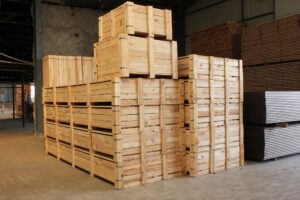
Learn what you can do to eliminate damage during transportation of your product.
Packaging damage is an occasional and unfortunate consequence of moving products through the packaging supply chain. However, before you can make adjustments to your package to ensure the least amount of damage occurs, you must consider how the damage happens and what factors are at play. Eliminating damage is essential because if your product is damaged on its way to consumers, it can be turned away from distribution centers or rejected by customers. When that happens, you hurt your reputation and lose money and product. If you wish to eliminate damage in your packaging supply chain, consider the following areas in which damage is likely to occur.
Packaging
The material and strength of your packaging can certainly factor into potential damage. You can consider the flute and wall construction of corrugated boxes. Certain types of cardboard are better for shipping heavy items, some are resistant to puncture, and others are best for printing and display.
You should also consider stackability. What does the unit sit on in the warehouse? What are the pallets made of, and what is their condition? How many levels can the units be stacked without being compressed?
Palletizer Performance
There should be no gaps between cases stacked on top of each other on pallets. However, cases can shift and create a gap that leads to product damage. If the gaps originate with the palletizer, this increases the potential for damage.
The Effectiveness of Stretch-Wrap
When using a stretch-wrap machine, it is essential to ensure compatibility between the film used and stretch-wrap machinery. Then, examine the force-to-load measurement or the amount of strength/force applied to hold the product together. If you are not following all recommended measurements for your packaging, the risk of damage increases.
Trailer Loading Pattern
It can be difficult to load a large trailer full of packages, but you can maximize the space to eliminate damage. Your loading decisions should balance productivity, safety, transportation, equipment costs, and product protection. One solution is to “pinwheel” or alter the direction of every other pallet. Pinwheeling helps to utilize the space in a trailer when there may be inadequate width to load two pallets side by side.
You may also stabilize and secure loads in a trailer by using airbags, partitions, braces, and load locks.
Transportation
If packages are traveling a long distance, you can never be sure which conditions they will encounter. Changes in road conditions and elevation can potentially contribute to damage if the products are not packaged safely in the trailer. For instance, shock and vibration can affect packages in stiff trailers with no cushion load.
This can be avoided by using air-ride suspension trailers adapted with air hoses that span from the truck to the trailer. These create a smoother ride regardless of road conditions.
When looking for problem areas in your packaging supply chain, you must be laser-focused on specific targets. Consider every phase of the supply chain and consider what packaging improvements you can make to eliminate damage.
Liquid Filling and Packaging Experts
For over 70 years, FILAMATIC has provided a wide range of liquid filling machines to the packaging market. We create flexible, customized solutions for every stage of your business growth. Whether you require a single machine, a complete turnkey solution, or a fully-automated, integrated Monobloc system, we have the liquid filling experience that will exceed your expectations.
For more information on liquid filling, capping and labeling solutions, please call 866.258.1914 or visit – www.filamatic.com/contact-us.
